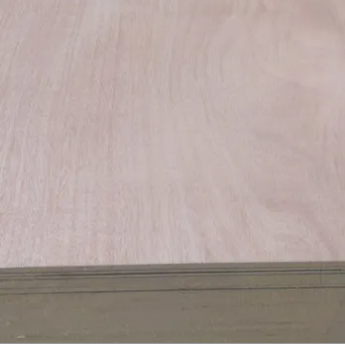When it comes to making furniture that is both sturdy and beautiful, the choice of material is crucial. Known for its versatility and strength, plywood has become a popular choice for professional furniture makers and passionate DIY enthusiasts alike. However, not all plywood is created equal, and understanding the different types of plywood is essential to ensuring that your furniture project is not only visually appealing but also durable. In this article, we'll explore the various types of plywood, including commercial plywood, and provide valuable insight into making the right choice for your furniture endeavours.
Plywood: A Brief Overview
Before delving into the diverse world of plywood, let's understand what plywood is. Plywood is an engineered wood product that consists of thin wood veneers bonded together with adhesives. These veneer layers or plies are usually arranged so that the grain direction of neighbouring plies is perpendicular to each other. This unique cross-grain structure gives plywood superior strength and stability, making it ideal for a variety of applications.
Now, let's delve into the different types of plywood commonly used in furniture manufacturing:
1. Structural Plywood:
Structural plywood, also known as construction plywood, is primarily designed for structural applications such as framing and sheathing. While it may not be the first choice for making fine furniture, it is worth mentioning that it is one of the basic types of plywood used in the construction industry. Structural plywood is usually not as aesthetically pleasing as other species and may not have the same surface finish quality.
2. Commercial plywood:
Commercial plywood, often called MR (moisture resistant) plywood, is one of the most widely used types of plywood in the furniture industry. It is known for its affordability and versatility, making it a popular choice for a variety of furniture. Commercial plywood is made by bonding multiple layers of wood veneers together with a moisture-resistant adhesive that provides a degree of protection against moisture.
One of the main advantages of commercial plywood is its cost-effectiveness. It strikes a balance between quality and affordability, making it an attractive option for budget-conscious furniture makers. However, it is worth noting that commercial plywood may not be as durable as some quality alternatives and may require additional finishing and sealing to enhance its moisture and wear resistance.

3. Hardwood plywood:
Hardwood plywood is of higher quality and is often used to make high-end furniture. Unlike commercial plywood, which may have a softwood veneer interior, hardwood plywood is constructed with hardwood veneers everywhere. This results in a more attractive appearance and higher durability.
Hardwood plywood is available in a variety of species, including oak, birch, maple and cherry. Each species has its own unique grain patterns and colours, allowing furniture manufacturers to choose the product that best suits their design vision. The use of hardwood veneers also makes this plywood more resistant to wear and tear, making it an excellent choice for furniture that needs to withstand daily use.
4. Cork Plywood:
Softwood plywood, as the name suggests, is made from softwood species such as pine, cedar or fir. While it may not be as visually appealing as hardwood plywood, it is an excellent choice for furniture that does not require an intricate finish. Softwood plywood is commonly used to make outdoor furniture, cabinets and other utility items.
One of the advantages of cork plywood is that it is affordable and easy to work with. It can be stained or painted to achieve the desired aesthetic, and its strength properties make it suitable for a wide range of applications. However, it may not have the same level of durability as hardwood plywood.
Explore more:What are the advantages of living in an expandable container home?Can an expandable home office be customized?Dive into Elegance: 8 Best Swimming Pool Mosaic IdeasThe Benefits of UV Varnish for FloorAchieve the Velvet Effect Paint Look with These Expert TipsWhat is the purpose of dams and their role in water management?Expanded Metal vs. Perforated Metal
5. Marine plywood:
Marine plywood is the ultimate choice as far as moisture resistance is concerned. It is specially designed to withstand water and moisture, making it ideal for outdoor and marine applications. Marine plywood is made from high-quality hardwood veneers and waterproof adhesives, ensuring that it can withstand harsh environmental conditions without delamination or deterioration.
While marine plywood is primarily designed for boat building and other water-related projects, it is sometimes used in furniture manufacturing, especially for outdoor use. Its superior resistance to rot, fungal growth and warping makes it a reliable choice for furniture exposed to the natural environment.
6, Decorative Plywood:
Decorative plywood, also known as veneer plywood, combines the structural benefits of plywood with the aesthetic appeal of solid wood veneer. This type of plywood is coated with a thin layer of high-quality wood veneer, creating a stunning visual appearance. It allows furniture makers to achieve the look of exotic hardwoods without the cost and weight associated with solid wood.
Decorative plywood is commonly used to create individual furniture, cabinet doors and interior panelling. Veneer options range from traditional wood species such as walnut and mahogany to more exotic choices such as zebrawood or knotty veneer. It offers the flexibility of custom furniture design while maintaining the structural integrity of plywood.
Choosing the Right Plywood for Your Furniture Project
Choosing plywood for your furniture project should be based on your specific needs, budget and design vision. Here are some key factors to consider when choosing the right plywood:
1. Project requirements: Consider the intended use of the furniture. If you are making outdoor furniture, marine plywood or moisture resistant options may be essential. For indoor furniture, decorative or hardwood plywood can provide the desired finish and durability.
2. Budget: Determine the budget for your project. While quality plywood offers superior quality, they cost more. Evaluate whether the additional cost is reasonable for your particular application.
3. Aesthetics: Consider the visual appeal you want to achieve. Decorative plywood is an excellent choice for projects where aesthetics are important, while structural plywood may be sufficient for utility pieces.
4. Workability: Consider your woodworking skills and the tools you have access to. Some plywood types are easier to work with than others, so choose one that matches your level of expertise.
5. Finish: Decide whether you plan to paint, stain or expose the plywood. This will affect your choice of plywood and any additional finishes required.
6. Environmental impact: If sustainability is a concern, look for plywood products certified by organisations such as the Forest Stewardship Council (FSC), which ensures responsible forestry practices.
In conclusion, it's important to understand the different types of plywood when starting a furniture manufacturing project. Whether you choose commercial plywood, hardwood plywood, marine plywood or decorative plywood, each type has unique benefits and characteristics. By carefully evaluating your project requirements and budget, you can make an informed choice that will produce furniture that is not only functional, but also beautiful and durable. Ultimately, the right choice of plywood is a critical step in creating furniture that will stand the test of time and delight users for years to come.
Explore more:HDPE Pipe Floats: The Ultimate Guide to Buoyancy SolutionsWhat is a Geotube, and how is it used for erosion control and sediment dewatering?Steel Warehouse Buildings: A Comprehensive Guide to Optimize Your InvestmentWhat are the advantages of choosing granite headstones for lasting memorialization?Exploring Types of Guardrail PostsThe Importance of Stormwater ManagementWhy is it important to add hpmc to tile adhesive?












Comments
Please Join Us to post.
0